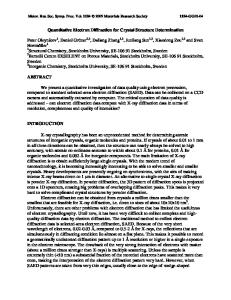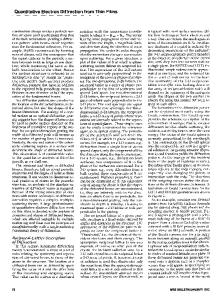Crystal structure refinement from electron diffraction data
- PDF / 239,122 Bytes
- 7 Pages / 612 x 792 pts (letter) Page_size
- 2 Downloads / 336 Views
TALLOGRAPHIC SOFTWARE
Crystal Structure Refinement from Electron Diffraction Data A. P. Dudka, A. S. Avilov, and G. G. Lepeshov Shubnikov Institute of Crystallography, Russian Academy of Sciences, Leninskiœ pr. 59, Moscow, 119333 Russia e-mail:[email protected] Received January 24, 2007
Abstract—A procedure of crystal structure refinement from electron diffraction data is described. The electron diffraction data on polycrystalline films are processed taking into account possible overlap of reflections and two-beam interaction. The diffraction from individual single crystals in an electron microscope equipped with a precession attachment is described using the Bloch-wave method, which takes into account multibeam scattering, and a special approach taking into consideration the specific features of the diffraction geometry in the precession technique. Investigations were performed on LiF, NaF, CaF2, and Si crystals. A method for reducing experimental data, which allows joint electron and X-ray diffraction study, is proposed. PACS numbers: 61.66.Fn, 71.20.-b DOI: 10.1134/S1063774508030255
INTRODUCTION High-energy (several tens or hundreds of kiloelectronvolts) electron diffraction is a powerful tool for structural identifications. Currently, it is one of the most promising techniques in such important fields as analysis of nanomaterials and development of nanotechnologies. In the case of high-energy electron diffraction, the Ewald sphere in the diffraction direction approaches a plane, as a result of which a large number of diffracted beams arise. Therefore, electron scattering is described in the general case by the dynamic theory, which takes into account redistribution of the energy incident on an object between scattered beams. At the same time, structural analysis of crystals requires knowledge of the structural amplitudes in the kinematic approximation (kinematic structural amplitudes). Electron-diffraction structure analysis (EDSA) is performed on thin polycrystalline films. Thus, the thickness of microcrystallites is sufficiently small for dynamic effects to occur, and, since a film has a polycrystalline microstructure, the influence of dynamic effects is averaged to a large extent [1–3]. Therefore, EDSA most often uses the kinematic approximation with introduction of corrections to two-beam scattering; in most cases, such an approximation is sufficient to obtain reliable structural data. In addition, the features of high-energy electron diffraction that are related to the possibility of reconstructing the distribution of the electrostatic potential and high sensitivity of electrons in the range of small angles to the redistribution of valence electrons during formation of chemical bonds make it possible to use this
method for quantitative construction of the electrostatic potential from the electron diffraction data on the distribution of the electrostatic potential and electron density. To carry out such investigations, it is necessary to have a maximum possible complete set of kinematic structural ampl
Data Loading...











